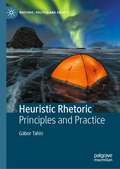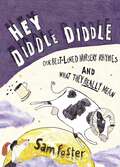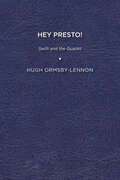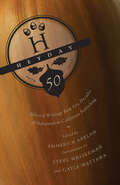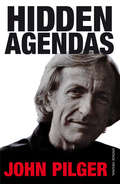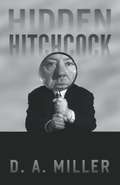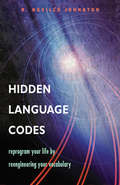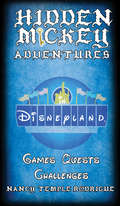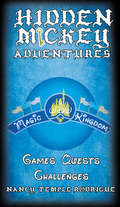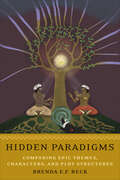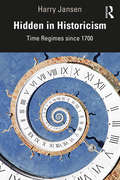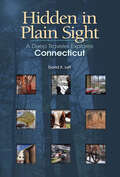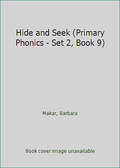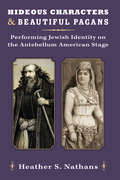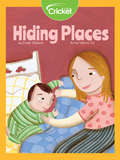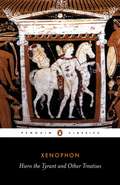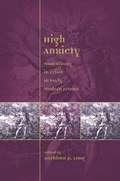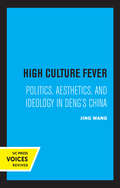- Table View
- List View
Heuristic Rhetoric: Principles and Practice (Rhetoric, Politics and Society)
by Gábor TahinThis book introduces a novel approach to the analysis and practice of persuasive speaking and writing: heuristic rhetoric. The new method has evolved to fulfil the need at universities, government departments, political organisations, business enterprises and other public institutions for a modern practical alternative to classical rhetoric, which is, in the author’s view, no longer capable of giving a complete description of contemporary, predominantly mediatised, forms of public persuasive discourse, whilst other competing disciplines, such as critical discourse analysis or strategic manoeuvring, have not yet produced a set of tools, which have the comprehensive nature and practical orientation of Classical Greek and Roman rhetorical system. The book expounds heuristic rhetoric as an inter-disciplinary method to develop advanced skills of critical and strategic reasoning. Applying a novel set of principles for the strategic analysis of persuasive reasoning in complex rhetorical situations, the method emphasizes preparing and continuously adjusting argumentation according to the demands of unpredictable circumstances.
Hey Diddle Diddle: Our Best-Loved Nursery Rhymes and What They Really Mean
by Sam FosterThis charming compilation of 40 of the best-loved traditional nursery rhymes offers clues as to their true meanings and often surprising origins. Many were not nonsense verses for the playground but served as satirical commentaries on political events of the day. This humorously illustrated book offers a fascinating trip down memory lane.
Hey Diddle Diddle: Our Best-Loved Nursery Rhymes and What They Really Mean
by Sam FosterThis charming compilation of 40 of the best-loved traditional nursery rhymes offers clues as to their true meanings and often surprising origins. Many were not nonsense verses for the playground but served as satirical commentaries on political events of the day. This humorously illustrated book offers a fascinating trip down memory lane.
Hey Presto!: Swift and the Quacks
by Hugh Ormsby-LennonIn this book the author reveals how medicine shows, both ancient and modern, galvanized Jonathan Swift’s imagination and inspired his wittiest satiric voices. Swift dubbed these multifaceted traveling entertainments his Stage-itinerant or “Mountebank’s Stage.” In the course of arguing that the stage-itinerant formed an irresistible model for A Tale of a Tub, Ormsby-Lennon also surmises that the mountebank’s stage will disclose that missing link, long sought, which connects the twin objects of Swift’s ire: gross corruptions in both religion and learning. In the early modern medicine show, the quack doctor delivered a loquacious harangue, infused with magico-mysticism and pseudoscience, high-astounding promises, and boastful narcissism. To help him sell his panaceas and snake-oil, he employed a Merry Andrew and a motley troupe of performers. From their stages, many quacks also peddled their own books, almanacs, and other ephemera, providing Grub Street with many of its best-sellers. Hacks practiced, quite literally, as quacks. Merry Andrew and mountebank traded costumes, whiskers, and voices. Swift apes them all in the Tale. Published by University of Delaware Press. Distributed worldwide by Rutgers University Press.
Heyday at Fifty: Selected Writings from Five Decades of Independent California Publishing
by Emmerich AnklamA polyphonic celebration of a preeminent California publisher, featuring over 35 pieces drawn from across Heyday's distinguished history."Confluence is a big part of California, and Heyday has been the glorious secret center of confluence for many years, the place where art and literature and Native lore and environmental history all converge." —Rebecca SolnitSince its founding in 1974, Heyday—an independent nonprofit based in Berkeley—has published more than 500 books that have shaped California's deepest, most abiding sense of itself. Heyday now gathers three dozen highlights drawn from half a century of distinguished publishing, featuring writing by the likes of Deborah A. Miranda, Gary Snyder, Jane Smiley, Linda Ronstadt, John Muir Laws, Obi Kaufmann, and founder Malcolm Margolin. Taken together, these pieces embody Heyday's guiding ethos: to celebrate the natural wonders of the Golden State, to explore California's vibrant arts and history, to amplify the voices of the West's Indigenous peoples, and to foster civic engagement and social justice. Edited by Emmerich Anklam, and featuring an introduction by publisher Steve Wasserman and general manager Gayle Wattawa, Heyday at Fifty serves as a testament to Heyday's preeminent place in California letters.
Hidden Agendas
by John PilgerIn this powerful book, journalist and film maker John Pilger strips away the layers of deception, dissembling language and omission that prevent us from understanding how the world really works. From the invisible corners of Tony Blair's Britain to Burma, Vietnam, Australia, South Africa and the illusions of the 'media age', power, he argues, has its own agenda. Unchallenged, it operates to protect its interests with a cynical disregard for people - shaping, and often devastating, millions of lives. By unravelling the hidden histories of contemporary events, Pilger allows us to read between the lines. He also celebrates the eloquent defiance and courage of those who resist oppression and give us hope for the future. Tenaciously researched and written with passion and wit, Hidden Agendas will change the way you see the world.
Hidden Designs: The Critical Profession and Renaissance Literature (Routledge Revivals)
by Jonathan CreweThis 1986 study offers a challenging contribution to the on-going critical debate surrounding the English literary Renaissance. Although informed by the ‘new historicism’ and post-structuralism, Hidden Designs makes a plea for criticism to be practiced in its own name rather than in the name of theory, and opposes the hyper-professionalisation of literary studies in favour of the broader communal functions of criticism. Major Renaissance authors and their recent critics are placed under ‘suspicion’ as Crewe explores the elements of ‘criminality’ inherent in the powerful interests –personal, institutional, political and cultural – served by the literary enterprise, or channelled through it. Revisionary readings of Sidney, Spenser, Puttenham and Shakespeare are linked by a continuing commentary on the history and theoretical claims of Renaissance criticism.
Hidden Hitchcock
by D. A. MillerNo filmmaker has more successfully courted mass-audience understanding than Alfred Hitchcock, and none has been studied more intensively by scholars. In Hidden Hitchcock, D. A. Miller does what seems impossible: he discovers what has remained unseen in Hitchcock's movies, a secret style that imbues his films with a radical duplicity. Focusing on three films--Strangers on a Train, Rope, and The Wrong Man--Miller shows how Hitchcock anticipates, even demands a "Too-Close Viewer." Dwelling within us all and vigilant even when everything appears to be in good order, this Too-Close Viewer attempts to see more than the director points out, to expand the space of the film and the duration of the viewing experience. And, thanks to Hidden Hitchcock, that obsessive attention is rewarded. In Hitchcock's visual puns, his so-called continuity errors, and his hidden appearances (not to be confused with his cameos), Miller finds wellsprings of enigma. Hidden Hitchcock is a revelatory work that not only shows how little we know this best known of filmmakers, but also how near such too-close viewing comes to cinephilic madness.
Hidden Language Codes
by R. Neville JohnstonWhen R. Neville Johnston was shot three times in 1977, he died. But he came back knowing some things he hadn't known before. That the universe is made of up of vibrations for one. And that some of the most meaningful vibrations are the words we use in everyday thought and speech. Obviously it behooves us to choose our words with care so we can create the life we want.Hidden Language Codes is a book about thought. Where we go in life is directly related to our mastery and command of our thoughts and our language. In evolving, we naturally change the way we think. A method of accelerating this process is to change the very words we think with. This book is the key to learning words that will improve our lives and giving up the ones that hold us back. Learn to use power words--words that serve us well--such as "acceptance," "faith," even "MacGyver," and the key power word, "love." Those words that do not serve us well include "greed," "blame," "hard," and the poster child for disempowerment/slave thinking "can't."Our language is full of unconscious triggers--the words we speak are making decisions for us, running us. As long as we continue to try, need, guess, want, whine, and victim our way through life, we sabotage our own goals and happiness. Never use these words again. Take charge of your thoughts and speech, and your life will follow suit.
Hidden Mickey Adventures in Disneyland
by Nancy Temple RodrigueEXPLORE DISNEYLAND® IN A WHOLE NEW WAY See your favorite Park with a new set of eyes! GAMES, PUZZLES and CHALLENGES AWAIT AS YOU RACE THROUGH DISNEYLAND® Work alone, with friends, or team up and challenge them. Score Points on each quest you finish. See who knows the park the best as you decipher cryptic clues and find hidden symbols. TEST YOUR KNOWLEDGE OF THE MAN THAT STARTED IT ALL: WALT DISNEY Almost all the scavenger hunts are handicap accessible. FUN FOR ALL AGES! From the author of the acclaimed Hidden Mickey Adventures series. HIDDEN MICKEY ADVENTURES: in Disneyland is the start of the Hidden Mickey Adventures series, where readers will enjoy more action-adventure mysteries about Walt Disney and Disneyland®
Hidden Mickey Adventures in WDW Magic Kingdom
by Nancy Temple RodrigueEXPLORE WALT DISNEY WORLD MAGIC KINGDOM® IN A WHOLE NEW WAY See your favorite Park with a new set of eyes! GAMES, PUZZLES and CHALLENGES AWAIT AS YOU RACE THROUGH W D W MAGIC KINGDOM® Work alone, with friends, or team up and challenge them. Score Points on each quest you finish. See who knows the park the best as you decipher cryptic clues and find hidden symbols. TEST YOUR KNOWLEDGE OF THE MAN THAT STARTED IT ALL: WALT DISNEY Almost all the scavenger hunts are handicap accessible. FUN FOR ALL AGES! From the author of the acclaimed Hidden Mickey Adventures series. HIDDEN MICKEY ADVENTURES: in WDW Magic Kingdom is part of the Hidden Mickey Adventures series, where readers will enjoy more action-adventure mysteries about Walt Disney and Disneyland®
Hidden Paradigms: Comparing Epic Themes, Characters, and Plot Structures
by Brenda E.F. BeckUnderstanding an epic story’s key belief patterns can reveal community-level values, the nature of familial bonds, and how divine and human concerns jockey for power and influence. These foundational motifs remain understudied as they relate to South Asian folk legends, but are nonetheless crucial in shaping the values exemplified by such stories’ central heroes and heroines. In Hidden Paradigms, anthropologist Brenda E.F. Beck describes The Legend of Ponnivala, an oral epic from rural South India. Recorded in 1965, this story was sung to a group of village enthusiasts by a respected pair of local bards. This grand legend took more than thirty-eight hours to complete over eighteen nights. Bringing this unique example of Tamil culture to the attention of an international audience, Beck compares this virtually unknown South Indian epic to five other culturally significant works – the Ojibwa Nanabush cycle, the Mahabharata, an Icelandic Saga, the Bible, and the Epic of Gilgamesh – establishing this foundational Tamil story as one that engages with the same universal human struggles and themes present throughout the world. Copiously illustrated, Hidden Paradigms provides a fresh example of the power of comparative thinking, offering a humanistic complement to scientific reasoning.
Hidden Surprises
by Roger C. Farr Dorothy S. StricklandAs you read Hidden Surprises, you will meet characters who learn about themselves and others. You may discover animals you have never seen before. You may even see some old friends in new stories.
Hidden in Historicism: Time Regimes since 1700
by Harry JansenHidden in Historicism considers how the nineteenth-century philosophy of historicism depicts three "forgotten time regimes": a time of rise and fall, an ambiguous time of synchronicity of the non-synchronous, and a time in which decisive moments dominate. Before the eighteenth century, time was past-oriented. This inversed in the Enlightenment, when the future became dominating. Today, this time of progress continues to be embraced as a "time of the modern". Yet, inequality, increasing violence and climate change lead to doubts over a bright future. In this book, Harry Jansen moves away from the heritage of Reinhart Koselleck and his single time of the modern towards a historicist, threefold temporal approach to history writing. In the time regime of the twenty-first century past, present and future coexist. It is a heterogeneous time that takes on the three forms of historicism. Jansen’s study shows how all three times exist together in current historiography and contribute to a better understanding of the world today. Based on the idea that an incarnated time rules everything that happens it reality, the book offers a fresh perspective on the ongoing discussion about time and time regimes in contemporary philosophy and theory of history for students and scholars, both time specialists and the non-specialist.
Hidden in Plain Sight: A Deep Traveler Explores Connecticut (Garnet Books)
by David K. LeffThe art of discovering cultural and natural treasures in everyday landscapes In the course of the mundane routines of life, we encounter a variety of landscapes and objects, either ignoring them or looking without interest at what appears to be just a tree, stone, anonymous building, or dirt road. But the "deep traveler," according to Hartford Courant essayist David K. Leff, doesn't make this mistake. Instead, the commonplace elements become the most important. By learning to see the magic in the mundane, we not only enrich daily life with a sense of place, we are more likely to protect and make those places better. Over his many years working at the Connecticut Department of Environmental Protection and writing about the state's landscape, Leff gained unparalleled intimacy while traveling its byways and back roads. In Hidden in Plain Sight, Leff's essays and photographs take us on a point-by-point journey, revealing the rich stories behind many of Connecticut's overlooked landmarks, from the Merritt Parkway and Cornwall's Cathedral Pines to roadside rock art and centuries-old milestones.
Hide and Seek: A Grammar Tales Book to Support Grammar and Language Development in Children (Grammar Tales)
by Jessica HabibPete, Jem and Belle play hide and seek. Pete has a very good hiding spot – will they ever find him? Targeting Subject-Verb-Object sentences and prepositions, this book provides repeated examples of early developing syntax and morphology which will engage and excite the reader while building pre-literacy skills and make learning fun, as well as exposing children to multiple models of the target grammar form. Perfect for a speech and language therapy session, this book is an ideal starting point for targeting client goals and can also be enjoyed at school or home to reinforce what has been taught in the therapy session.
Hideous Characters and Beautiful Pagans: Performing Jewish Identity on the Antebellum American Stage
by Heather NathansWhile battling negative stereotypes, American Jews carved out new roles for themselves within the first theatrical entertainments in America. Jewish citizens were active as performers, playwrights, critics, managers, and theatrical shareholders, and often tied their involvement in these endeavors to the patriotic rhetoric of the young republic as they struggled to establish themselves in the new nation. Examining play texts, theatrical reviews, political discourse, and public performances of Jewish rights and rituals, Hideous Characters and Beautiful Pagans argues that Jewish stage types shed light on our understanding of the status of Jewish Americans during a critical historical period. Using an eclectic range of sources including theatrical reviews, diaries, letters, cartoons, portraiture, tax records, rumors flying around the tavern, and more, Heather S. Nathans has listened for the echoes of vanished audiences who witnessed and responded to these stereotypes onstage, from the earliest appearance of Shylock on an American stage in 1752 to Jewish theater artists on the eve of the Civil War. The book integrates social, political, and cultural histories, with an examination of those texts (both dramatic and literary) that shaped the stage Jew.
Hiero the Tyrant and Other Treatises
by XenophonOne of Socrates' Athenian disciples in his youth, Xenophon (c. 498-354 bc) fought as a mercenary commander in Cyrus the Younger's campaign to seize the Persian throne, and later wrote a wide range of works on history, politics and philosophy. These six treatises offer his informed insights into the nature of leadership. In the dialogue between the poet Simonides and Hiero, tyrant of Syracuse, Xenophon provides a consummate consideration of the burdens of being an absolute dictator and the superior happiness of the private man. Elsewhere, his biography of King Agesilaus II of Sparta depicts the author's patron as a model of piety, justice, courage and wisdom, while other texts consider the essential qualities of the cavalry commander, analyse the skills of the horseman and the hunter, and advance a bold economic plan for democratic Athens.
High Anxiety: Masculinity in Crisis in Early Modern France (Sixteenth Century Essays & Studies #59)
by Kathleen P. LongThis collection explores the evolution of notions about masculinity during the intense crisis of Renaissance and early modern France. Authors of the period reflect the anxieties about masculinity that became more pronounced against the backdrop of major events and innovations of the period: the religious conflict in France, the repeated questioning of religious and royal authority, the revival of Greek skepticism, the discovery of the New World, and the rise of clinical medicine. These events in turn fueled growing doubt concerning the fixed and hierarchical nature of gender distinction, a distinction upon which many felt French culture was dependent for its very survival.
High Anxiety: Masculinity in Crisis in Early Modern France (Sixteenth Century Essays & Studies)
by Kathleen P. LongThis collection explores the evolution of notions about masculinity during the intense crisis of Renaissance and early modern France. Authors of the period reflect the anxieties about masculinity that became more pronounced against the backdrop of major events and innovations of the period: the religious conflict in France, the repeated questioning of religious and royal authority, the revival of Greek skepticism, the discovery of the New World, and the rise of clinical medicine. These events in turn fueled growing doubt concerning the fixed and hierarchical nature of gender distinction, a distinction upon which many felt French culture was dependent for its very survival.
High Culture Fever: Politics, Aesthetics, and Ideology in Deng's China
by Jing WangThis title is part of UC Press's Voices Revived program, which commemorates University of California Press’s mission to seek out and cultivate the brightest minds and give them voice, reach, and impact. Drawing on a backlist dating to 1893, Voices Revived makes high-quality, peer-reviewed scholarship accessible once again using print-on-demand technology. This title was originally published in 1996.
High Point: Success In Language, Literature, Content
by Alfredo Schifini Deborah Short Josefina Villa Mil TinajeroAn easy to read English book.
High Point: Success in Language (Level B)
by Alfredo Schifini Deborah Short Josefina Villa Mil TinajeroA paragraph is a group of sentences that all tell about the same idea. One sentence gives the main idea of the paragraph. The other sentences give details that support the main idea.
